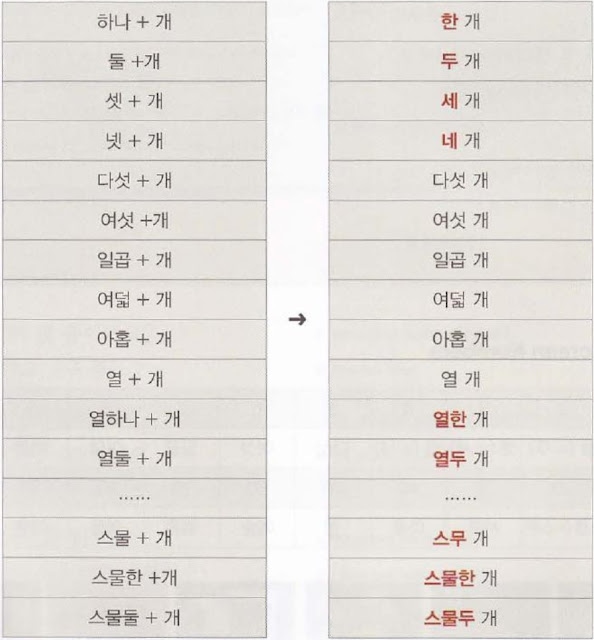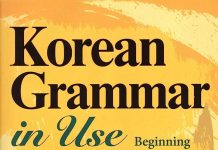 There are two ways to express numbers in Korean. One is by using Sino-Korean numbers, and the other is by using native Korean numbers. Sino-Korean numbers are used to express such things as telephone numbers, bus route numbers, height, weight, address numbers, years, months, minutes, seconds, and prices.
There are two ways to express numbers in Korean. One is by using Sino-Korean numbers, and the other is by using native Korean numbers. Sino-Korean numbers are used to express such things as telephone numbers, bus route numbers, height, weight, address numbers, years, months, minutes, seconds, and prices.
 1. In Korean, large numbers are read based on units of ten thousand (만) instead of thousands (천). Thus, 354,790 is interpreted as 35,4970 and read as 35만 4970 (삼십오만 사천구백칠십). Similarly, 6,354,790 is interpreted as 635,4790 and read as 635만 4790 (육백삼십오만 사천구백칠십).
1. In Korean, large numbers are read based on units of ten thousand (만) instead of thousands (천). Thus, 354,790 is interpreted as 35,4970 and read as 35만 4970 (삼십오만 사천구백칠십). Similarly, 6,354,790 is interpreted as 635,4790 and read as 635만 4790 (육백삼십오만 사천구백칠십).
• 26354790 -> 2635/4790
이천육백삼십오만 사천칠백구십
2. When a number larger than 1 begins with 1, the initial 1(일) is not pronounced.
• 10: 십 (일십x) 110: 백십 (일백십x)
• 1,110: 천백십 (일천백십x) 11,110: 만 천백십 (일만 천백십x)
3. 16, 26, 36 … 96 are pronounced [심뉵] [이심뉵] [삼심뉵] … [구심늑].
4. ‘0’ is pronounced as either 공 or 영. When appearing in telephone numbers, 공 is used.
• 6508-8254 육오공팔의[에] 팔이오사
• 010-4783-0274 – 공일공 사칠팔삼의[에] 공이칠사
5. There are two ways to read telephone numbers.
• 7804-3577 칠팔공사의 [에] 삼오칠칠
-> 칠천팔백사 국의[에] 삼천오백칠십칠 번
* In this case 의 is pronounced [에],not [의].
Other Examples:
A 사무실이 몇 층이에요? What floor is the office on?
B 9층이에요. (구층) The 9th floor.
A 전화번호가 뭐예요? What’s your phone number?
B 019-8729-9509예요. It’s 019-8729-9509.
(공일구 팔칠이구의[에] 구오공구)
A 몇 번 버스를 타요? What bus do you take?
B 705번 버스를 타요. (칠백오) I take bus number 705.
A 책이 얼마예요? How much is the book?
B 25.000원이에요. (이만오천) It’s 25,000 won.

Native Korean numbers are used to express time and units. They are generally used along with unit nouns that express the appropriate unit when counting things or people.
Examples of unit nouns include 명,마리, 개, 살, 병, and 잔. In these cases, the Korean numbers that precede these nouns are written in slighty different forms: 하나 becomes 한 (학생 한 명), 둘 becomes 두 (개 두 마리), 셋 becomes 세 (커피 세 잔), 넷 becomes 네 (콜라 네 병), and 스물 becomes 스무 (사과 스무 개), etc.

For example:
A 가족이 몇 명이에요? How many family members do you have?
B 우리 가족은 네 명이에요. We are a family of four.
A 동생이 몇 살이에요? How old are your younger siblings?
B 남동생은 스물세 살이에요. 여동생은 스무 살이에요.
My younger brother is 23, and my younger sister is 20.
A 여기 사과 세 개, 콜라 한 병 주세요.
Please give me (I’ll take/buy) these three apples and one coke.
B 네, 모두 오천육백 원입니다. Okay, your total is 5,600 won.


![[Korean grammar] ‘ㅅ’ 불규칙 (Irregular Conjugation)](https://sayhikorean.com/wp-content/uploads/2021/10/112.1.jpg)
![[Korean grammar] ‘ㅎ’ 불규칙 (Irregular Conjugation)](https://sayhikorean.com/wp-content/uploads/2021/10/111.1.jpg)
![[Korean grammar] ‘르’ 불규칙 (Irregular Conjugation)](https://sayhikorean.com/wp-content/uploads/2021/10/110.1.jpg)
![[Korean grammar] ‘ㄷ’ 불규칙 (Irregular Conjugation)](https://sayhikorean.com/wp-content/uploads/2021/10/109.1.jpg)
![[Korean grammar] ‘ㅂ’ 불규칙 (Irregular Conjugation)](https://sayhikorean.com/wp-content/uploads/2021/10/108.1.jpg)
![[Korean grammar] ‘ㄹ’ 불규칙 (Irregular Conjugation)](https://sayhikorean.com/wp-content/uploads/2021/10/107.1.jpg)
![[Korean grammar] ‘ㅡ’ 불규칙 (Irregular Conjugation)](https://sayhikorean.com/wp-content/uploads/2021/10/106.1.jpg)
![[Korean grammar] Indirect Quotation Contracted Forms: -대요, -래요, -재요, -냬요](https://sayhikorean.com/wp-content/uploads/2021/10/105.1.jpg)
![[Korean grammar] Indirect Quotations](https://sayhikorean.com/wp-content/uploads/2021/10/104.1.jpg)
![[Korean grammar] Direct Quotations: ‘Quoted speech’ + 하고/라고 + V](https://sayhikorean.com/wp-content/uploads/2021/10/103.1.jpg)
![[Korean grammar] A/V-(으)ㄴ/는데요 Additional Endings](https://sayhikorean.com/wp-content/uploads/2021/10/102.1.jpg)
이 주제를 좋아해요. 고마워요.